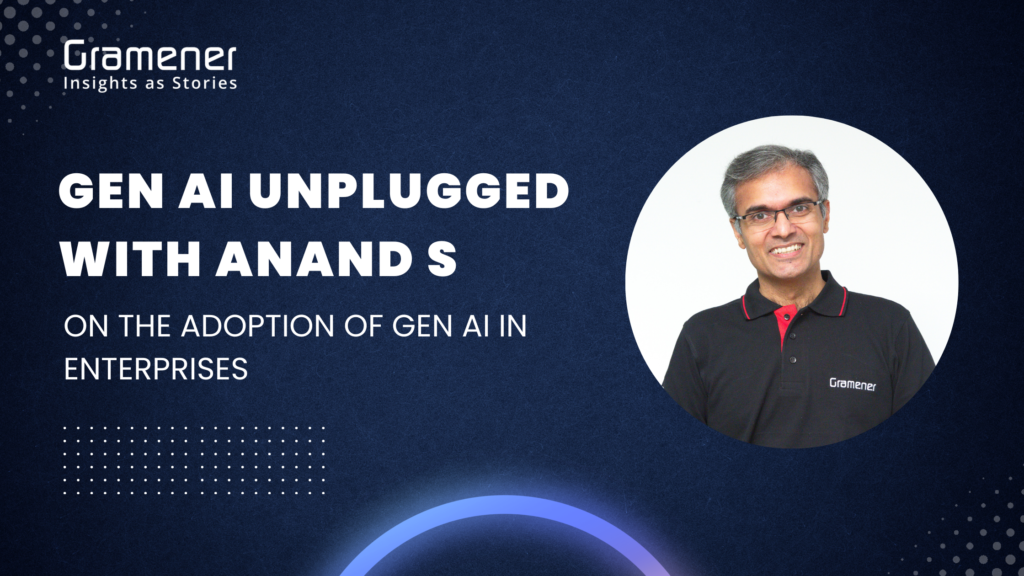
Reading Time: 5 mins
I asked Anand, our CEO, “What’s stopping enterprises from adopting Generative AI?”.
He replied, “Absolutely nothing.”
That’s where the whole script for the podcast changed (LOL). Every question I prepared sounded pointless. The whole talk was supposed to be around the challenges in Gen AI adoption in enterprises.
However, we recorded the podcast anyway (Here’s the full recording), and I got some insights on another important perspective – how decision-makers think when it comes to Gen AI adoption. More on that later in this article.
Ethically Using the Precious Gift of Gen AI
In one of his earlier podcasts on LLMs, Anand called Large Language Models a technology gifted by Aliens, without an instruction manual. I asked him what he meant by that and what the aliens intended us to do with this technology.
Anand playfully suggested the first idea that came to mind was mischief – imagining aliens giving us tech just for fun. He then compared it to historical scenarios, like the Spanish sharing advanced tools with less advanced civilizations like the Aztecs, and how it led to innovations and discoveries.
Anand explored three possible reasons aliens might share tech:
- Curiosity (like human mischief)
- Progress (creating markets for their goods)
- Kindness (hoping for mutual prosperity)
That brought an interesting thought about using this precious gift more ethically.
Anand emphasized that what might be considered right or wrong is often shaped by societal norms and specific contexts.
Turning towards tangible instances of unethical use of Generative AI, Anand cited a legal case where ChatGPT was misused by a lawyer to fabricate cases, leading to fines and repercussions. This example underscored the challenges posed by the misuse of AI in legal contexts, highlighting the need for vigilance and ethical guidelines.
Anand shared the need for evolving frameworks and perspectives to make ethical usage of Gen AI. Acknowledging the existence of unethical uses, he expressed optimism that these frameworks would adapt to mitigate risks over time.
The dialogue left a lingering thought: as enterprises embrace the potential of Generative AI, the journey must be guided by ethical considerations to harness its benefits responsibly.
What Can Gen AI Bring that Existing Technology Can’t?
In our conversation, I probed Anand on the unique value that Generative AI brings to enterprises compared to existing technologies like NLP and Machine Learning.
Anand illustrated this by taking us back to World War II, explaining how computers transformed the accuracy of bomb targeting. The shift wasn’t in the physics calculations, which a person could manually perform, but in speed, cost, and capacity. With computers, the process became faster, more cost-effective, and scalable beyond human limitations.
He emphasized that the essence of any technology’s effectiveness lies in making tasks cheaper, faster, easier, and scalable. Anand challenged the notion of “better” but highlighted that it doesn’t need to beat existing technology to be powerful.
Breaking it down, Anand discussed the practical aspects. Generative AI, he noted, excels in scalability. For instance, generating an image for a blog post or writing a blog post traditionally involved finding freelancers, a time-consuming process with limited accessibility. With Generative AI, the process becomes instantaneous, cost-effective, and accessible at any scale.
Is the Market Ready for the Gen AI Wave?
In our conversation, I asked Anand about the receptiveness of the market towards integrating Generative AI into their business processes. Anand provided a candid perspective on the current state of Gen AI adoption.
He noted that, in his experience, no organization outright rejects the idea of using Generative AI. Instead, the majority are still in the process of figuring out how to effectively incorporate it into their operations.
Anand drew parallels with the early days of Gramener in 2011 when data visualization faced a similar challenge of understanding and budget allocation.
Highlighting an interesting anecdote, Anand shared how the phrase “big data” unlocked budgets for data visualization projects. Similarly, in the current landscape, organizations express a willingness to invest in Gen AI. CEOs allocate budgets with a mandate to incorporate Gen AI into projects, even if the specifics are unclear. Anand recounted a scenario where a client essentially said, “Just do something cool with Gen AI.”
He emphasized that this initial phase of uncertainty and experimentation is not necessarily a negative aspect.
Drawing from a past experience with a bank, initially skeptical, he witnessed an 80 percent failure rate in funded initiatives. However, the remaining successes showcased the transformative power of data, leading to a cultural shift towards data-driven decision-making within the organization.
Anand concluded that despite initial hesitations and a high failure rate, the success stories demonstrate the value of the investments made in exploring the capabilities of Generative AI. This insight underscores the evolving nature of technology adoption, where experimentation and learning pave the way for broader acceptance and integration.
The Economics of Adopting Gen AI In Enterprises
The next question to Anand was about the role of cost in the adoption of services like GPT or DALL·E. I highlighted that these tools are reasonably priced, around $20 a month. My concern was whether cost is a significant factor in adoption, considering that Gramener builds solutions on top of these models.
Anand said that most organizations are in the exploratory phase, focused on understanding what can be achieved. At this juncture, cost isn’t their primary concern; the focus is on speeding up processes and potentially reducing costs in the long run. He clarified that during the exploration phase, organizations acknowledge that the initiative may not yield immediate cost savings.
However, he also pointed out that when moving into production, cost becomes a crucial consideration. He shared a practical example of evaluating the cost-effectiveness of using Gen AI to identify quality photos of drivers for a recruiting organization. He illustrated the economics, comparing the cost of a human evaluator versus the cost of utilizing technology.
Anand detailed the calculation, considering factors like evaluation speed, GPU costs, and the volume of requests. He highlighted that while a GPU may process tasks faster, the lower frequency of requests may make human labor more cost-effective for certain jobs.
In conclusion, Anand stressed that economic calculations involving fixed and variable costs play a pivotal role in determining whether a solution goes into production. The ultimate bottom line, he emphasized, is a key driver in the decision-making process for organizations adopting Generative AI.
Concerns of Enterprise Decision-makers on Gen AI Adoption
Anand highlighted two major concerns – Data security and accuracy of answering queries.
He highlighted the dual nature of security concerns, both in sending data outside an organization and receiving data into it.
Data security extends beyond legal implications. Anand discussed potential challenges in code ownership, with uncertainties arising when the code is generated by models trained on a mix of public and private data.
While LLM hallucinations, or the generation of inaccurate information, isn’t a prevalent concern, Anand acknowledged its potential impact, especially in applications interacting with the public.th the public. He cited an example of a bank developing a customer service chatbot, emphasizing the brand risk associated with the bot providing factually correct but undesirable responses.
Anand stressed the need for education in the current environment.
End Notes
From this conversation, I could find out the promising potential of Gen AI for businesses. While there are concerns about data security and legal issues, the overall mood among enterprise Gen AI adopters is curiosity and openness.
Anand’s practical examples, especially regarding security and legal matters, offer valuable insights. As we step into this new technological territory, education and solution-building become crucial. The focus is not just on understanding Generative AI intricacies but also on effectively communicating its advantages and addressing concerns.
The discussion with Anand highlights that we’re in a learning phase. Enterprise decision makers may not be objecting but educating them is essential for informed decisions. The journey of embracing Generative AI is exciting, demanding a balance between curiosity and caution.



